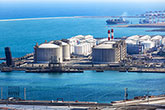Minor liquefaction outages fail to halt dip in gas prices
Published by Oliver Kleinschmidt,
Editorial Assistant
Tanks and Terminals,
Despite ongoing instability in the Middle East and additional US sanctions on Russia’s Arctic LNG 2 export facility, Asian spot LNG prices were down 9% week-on-week to approximately US$15.6 /million Btu on 7 November, due to warm autumn weather and weak demand during the first week of November.
Underground storage facilities in Europe were 99.6% full and climbing as of 6 November, with the December Title Transfer Facility (TTF) price down 14% week-on-week to approximately US$14.4 /million Btu on 7 November.
While the first week of November in 2020 and 2021 saw more withdrawals from storage than injections, this year the situation has reversed with 1 – 3 November 2023 averaging net injections of approximately 100 million m3/d.
Similarly, high volumes of around 109 million m3/d were last injected into European storage facilities during the first week of November 2022, when demand fell due to pandemic-related restrictions.
Outages in Australia reduce liquefaction capacity
In Australia, Gorgon LNG Train 3 tripped in late October, affecting potentially 1 – 2 shipments of LNG. The outage appeared short-lived and the impact on market sentiment minimal, with the liquefaction facility ramping up this week.
Planned maintenance at Prelude FLNG is lasting longer than expected, with the restart now expected in December instead of mid-November.
In terms of spot sales, some South Asian countries appear to be procuring LNG cargoes, including India Oil Corp. for 10 – 23 November delivery into the Ennore terminal priced at around US$15.6 per million Btu, and Bangladesh’s Rupantarita Prakritik Gas Co. Ltd (RPGCL) for December 2023 delivery.
Some Japanese gas utilities are also reportedly looking for swap opportunities for December 2023 delivery and January – February 2024 delivery.
By contrast, demand from Chinese and South Korean utilities remains muted.
Weather-wise, temperatures in Beijing are forecast to be below average from 9 – 13 November.
Japan sees reduced demand for power generation
In the downstream market, major Japanese power utilities reported combined gas storage levels of 2.37 million t on 5 November.
This is up 8.7% week-on-week and 18% higher than the five-year average from 2018 – 2022, but 6.3% lower than the 2.53 million t reported at end-October 2022.
In terms of generation from competing fuels, Joban Kyodo’s 600 MW Nakoso coal-fired power plant unit eight in northeastern Japan tripped on 6 November.
The plant’s restart date is not yet known, but an additional 60 000 t of LNG may be required if a gas-fired power plant needs to be brought online to make up for the loss of generation capacity.
In terms of other gas usage, the 277.5 MW Semboku Daiichi gas-fired power plant unit four went offline on 7 November for unknown reasons but is currently expected to restart on 9 November.
In Japan’s eastern Kanto region, the 300 MW Kimitsu Kyodo gas-fired power station unit five lowered output by around 30% from 6 – 8 November to conserve fuel, according to the Japan Electric Power Exchange (JEPX).
Power prices in Japan have been gradually climbing since the end of October, though current prices are still not high enough to incentivise Japanese power utilities to buy LNG in the spot market and generate additional electricity.
Sufficient US gas supply and storage levels
In the US, gas production remains high at approximately 107 billion ft3/d as of 6 November, compared to 102.6 billion ft3/d at the start of October.
In terms of liquefaction, feedgas levels into Freeport fully recovered on 7 November to around 2 billion ft3/d, following a 40% drop to approximately 783 million ft3/d on 5 November which led to venting.
In terms of the outlook for winter, Rystad Energy believes the US gas market can manage through the season even if colder-than-normal temperatures hit North America, due to already high levels of gas in storage.
As always, any short-term unforeseen event or an outage this winter could change the scenario slightly, but it is dependent on the length and magnitude of the outage.
Furthermore, a prolonged, widespread event or multiple extended events alongside an increase in LNG exports to support international demand beyond our expectations could rapidly draw down storage levels, which would have an upward impact on prices.
The data in this article has been provided by Rystad Energy and written by Senior Analyst, Masanori Odaka.
Read the article online at: https://www.tanksterminals.com/storage-tanks/09112023/minor-liquefaction-outages-fail-to-halt-dip-in-gas-prices/
You might also like
Advario joins net zero alliance
Advario has joined the SOHAR Port & Freezone Net Zero Alliance in the Middle East.

